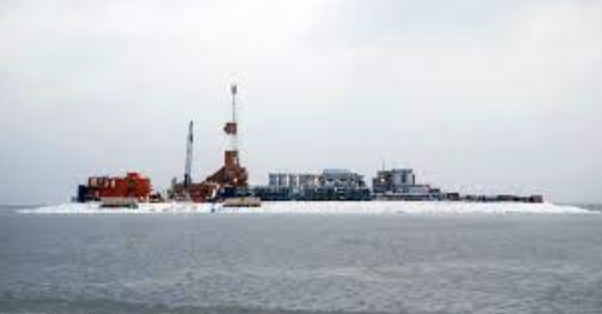The Willow project: the cause, the effects
The most recent legislation targeting Alaskan wilderness, and what it could mean for the wildlife.
One of the many newly-erected oil drilling sites within Alaska.
March 27, 2023
On March 13, the Willow project was approved by the Biden administration, allowing for a decades-long oil drilling venture to be initiated within the Northern Slope of Alaska’s National Petroleum Reserve.
The $8 billion oil drilling project created an uproar across the media, prompting environmental activists across the nation to send out more than one million letters in response, as well as acquiring nearly three million signatures on the change.org petition erected against it.
Although many understand this oil drilling project created by the Conocophillips oil exploration company is not good, fewer people understand the true depth and the negative impact this project will have upon not only the Alaskan wildlife, but the world as a whole.
Within the next 30 years, if the Willow project is drilled and used consistently, it will add around 263 million tons (239 million metric tons) of carbon emissions into the atmosphere, better known as greenhouse gasses. This is equivalent to the emission levels of roughly 64 coal-fired power plants, or 1.7 million passenger cars used over the same period.
The increased amount of greenhouse gasses into the atmosphere traps subsidiary heat, causing the Earth’s temperatures to rise gradually, leading to what many environmental scientists call global warming. Global warming is known to cause droughts, storms, heat waves, melting glaciers, rising sea levels, and warming seas; which can lead to harm against animals, destruction of habitats, and wreak havoc on the daily lives of everyday people.
Many blame the recent California weather extremes on these increased greenhouse gasses emitted into the atmosphere, and fear that if the Willow project were to be implemented, it would only escalate and worsen over time.
By creating the Willow project, not only will the drilling release dangerous levels of greenhouse gasses into the atmosphere, though it will further imperil the lives of animals living around the area of the National Petroleum Reserve. It would cause irreparable damage to ecosystems of that area, contaminate clean drinking water for those living around it, and disrupt different migration patterns for species of the area.
“We are enraged that the Administration has again approved Willow despite the clear threats posed to the Western Arctic’s vulnerable environment and communities,” Halle Templeton, a legal director of Friends of Earth, said. “We can only hope that the court sees this for what it is: another unlawful, faulty, and disastrous decision that must be stopped.”
Throughout this fight against the creation of Conocophillips’ project, many fingers have been pointed at who is at fault. The main one, of course, being President Joe Biden himself, due to what many see as hypocrisy behind his approval.
President Biden’s platform was built upon the fight against oil drilling on federal lands and expansion of clean energy across America, in hopes of preventing the emission of any more greenhouse gasses. Seeing as a project such as Conocophillips’ Willow project goes directly against this, many Americans feel betrayed by Biden’s choice to approve it due to the fact that its implementation was free of either a court order or a congressional order.
Other sides argue though that the President had very little legal choice in the matter; and although he was forced to approve it, he still fully understood the negative effects it would have on the environment. In regards to this, President Biden decreased the amount of land the project would take up by around 68,000 acres than originally planned by Conocophillips, allowing for less destruction of wildlife.
The lack of a legal choice was solely because the Biden administration was faced with a reluctance to fight Conocophillips in a court of law, which would have cost the government around $5 billion, according to administration officials.
Many environmentalists and concerned Americans are still skeptical about President Biden’s aid to the environment with the lowering of acreage, due to the fact that in creating the Willow project, it costs around $3 billion more than fighting against it.
A few environmentalist groups such as Friends of The Earth have taken it into their own hands to fight the oil drilling project by filing lawsuits and complaints. Such groups also include Earthjustice and Alaskan law firm Trustees for Alaska. Both groups argue that approving the Willow project goes against the National Environmental Policy act of 1970, as well as the Endangered species act, which was amended in 1997.
Each Act was implemented into law in order to protect and enhance wildlife habitats throughout the American wilderness. By creating the Willow project, environmentalist groups say that it is endangering species such as native polar bears who are already verging on extinction; and due to this, they believe this is not thought through well enough.
The Willow project is not in fact a new concept, and was originally drafted up and approved during former president Donald Trump’s term. At this time, however, it was shot down by judge Sharon Gleason, who stated that there was not enough analysis done on the project’s long term effects on the environment.
Although Judge Gleason shot it down in 2020, after analysis was done and evidence was presented once again in 2023, it was officially approved by Gleason who, at the time, also approved the disclosure of data to the public about the oil wells of the area sooner than later.
The disclosure ruling correlated with another Conocophillips lawsuit, in which the oil company sued Alaska Oil and Gas Conservation in order to block the commission from publicly releasing environmental data from the three of the Willow Project’s wells.
Conocophillips attorneys say this is because “competitive advantage resulting from its investment in the leases and drilling, for which it took on the risks of failure and paid tens of millions of dollars, will be lost” if the data were to be given out.
Many find this suspicious, stating that if the Willow project itself was not a vastly negative venture, there would be no reason to hide the environmental effects data from the public.
Overall, cries for change have spread like wildfire across American media, calling out for the reversal of the Willow Project and its implementation of Conocophillips’ oil drilling plan in the Alaskan Wilderness. Many environmentalists have begged for support from everyday citizens.
“It would be a blow to our climate and especially the climate of the Arctic, which is already warming faster than anywhere else on the planet.” Environment America said in their discussion of the Willow Project. “Together, we can stand up as Team Sanity and push back against more reckless oil drilling in the Arctic.”



